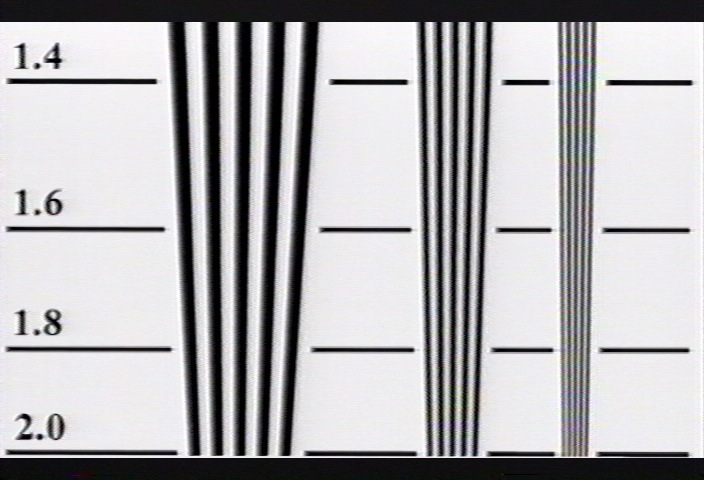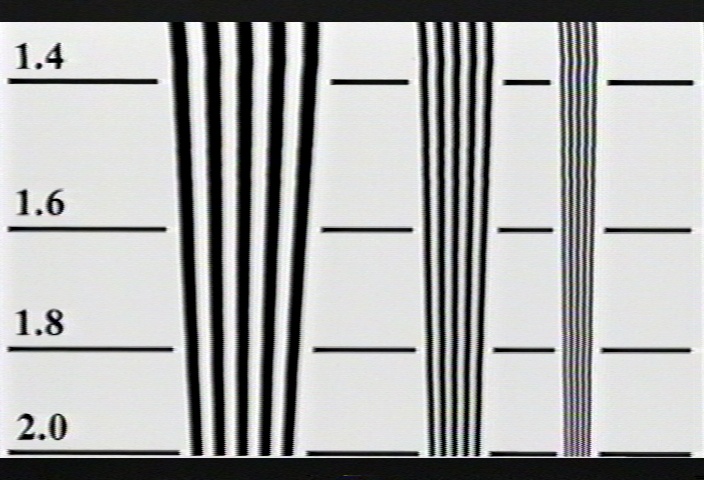I've been messing around capping a VHS tape of some test patterns I made, and just wanted to post these two caps to illustrate the benefits of a TBC (even a line TBC such as JVC puts in their top-of-the-line VCRs), even on a good source. I taped the following test pattern with my JVC HR-S9500U. Then I capped it playing from my Panasonic PV-V4820 S-VHS VCR (no TBC) and then from my JVC HR-S9900U with the TBC/DNR turned on.
Note how the JVC corrects the time base errors. For instance, note how on the Panasonic, the are "squiggles" in the vertical lines of the cap, and slight flagging at the top of the screen cap. Then check the JVC cap and notice how these time base errors are eliminated or at least greatly reduced.
Just thought some of you might want to actually "see" some of the benefits of a TBC. I always like showing real, empirical evidence of what we discuss here and generally take for granted.
Panasonic cap
JVC cap

+ Reply to Thread
Results 1 to 11 of 11
-
-
You can really see the effects of helical head tape stretch on the vertical lines of the Panny grab

The JVC grab looks like crap too, but it's a big improvement ANY TBC is way better than no TBC.
ANY TBC is way better than no TBC.
-
The JVC TBC/DNR "on" cap also shows the effect the other processing circuits have (noise reduction, edge enhancement, etc.)
Capturing analog videotape without the aid of a TBC guarantees image distortion of the type you have demonstrated in the first picture. -
Yup, saw it. Nice post.Originally Posted by Philbiker
 I also verified that it is the case with all my JVCs (HR-S9500U, HR-S9900U and HR-S7600U). They all have a better comb filter than any of the rest of my VCRs.
I also verified that it is the case with all my JVCs (HR-S9500U, HR-S9900U and HR-S7600U). They all have a better comb filter than any of the rest of my VCRs.
Capmaster, I'm unfamiliar with what the effects of helical head tape stretch look like, or are they just what cause the time base errors? Can you explain? Thanks.Originally Posted by Capmaster
gshelley, you're right, I did have the R3 edge correction on also for the JVC cap. Perhaps I should have turned it off.Originally Posted by gshelley61 -
Given the nature of the test, can one really say the difference is due to TBC?
-
The JVC line TBC that is built into the 9500,9600,etc. is particularly good at removing this type of instability. That is what it was designed to do. A TBC-1000, on the other hand, should be thought of more as a frame synchronizer, as it has little or no actual time base correction like you see above. In fact, under certain circumstances, the TBC-1000 output can have LESS stability than the original.
What the TBC-1000 does do is absolutely guarantee a continous sync/burst signal independent of anything happening at the source. This eliminates many video/audio skew problems because sync dropouts no longer exist at the capture card.
Using both of these TBCs together can yield optimal results for noisy and/or unstable sources.
Some of the earlier JVC VCRs (HR-S6800) have better transports that are more stable than the 9000 series, and they can look as good as a line TBC output. They also provide a bit more detail, since there is no noise reduction. It really is a shame that JVC forces DNR on whenever the TBC is on. -
After several years, my old SVHS camcorder began recording glitches in the video that caused areas of the picture to abruptly jerk from left to right by slight amounts during playback in any machine, including itself. Perhaps a worn capstan bearing or a sticky take up reel clutch? Anyway, these periodic impulses were amplified and transformed into sinusoidal disturbances by the TBC-1000, making the jerks more noticeable.
I think that the TBC-1000 expects a fairly stable source, and has not been designed to correct for step functions in timing.
I tried a FOR-A professional TBC (FA-300) and it reduced these disturbances quite a bit; actually made an improvement where the TBC-1000 had looked worse. Then I was lucky enough to win a JVC HR-S7600U VCR on EBay for $40. To my surprise, its line TBC completely eliminated these disturbances. Best $40 I ever spent!
For most situations, I think the TBC-1000 is fine. I actually have a TBC-3000 now that I always use whenever I capture to my Hauppauge PVR-250. Without a full frame TBC, I lose audio/video sync on tapes that have dropouts or gaps in the recordings.
I was just trying to point out that for actual timebase correction,
the JVC line TBCs outperform a TBC-1000/3000. -
This is an unfair statement. The two TBC's are made for different things. The "line TBC" is not alone. It has other embedded DNR circuits in those JVC's. The TBC-1000 is not made for "cleaning" an image. No TBC is. It is for maintaining stability. TBC-1000 does it quite well.Originally Posted by davideck
But the statement that "not TBC is perfect" is true. Some embedded errors can be made worse when the TBC tries to "fix" them. Not common, I see that maybe 0.05% of the time at most.Want my help? Ask here! (not via PM!)
FAQs: Best Blank Discs • Best TBCs • Best VCRs for capture • Restore VHS -
lordsmurf - you have quoted me out of context.
I stated that "for actual timebase correction, the JVC line TBCs outperform a TBC-1000/3000"
Do you disagree with my full statement?
Similar Threads
-
TBC suggestions: TBC-1000, AVT-8710, ADVC-300, TV1-TBC, or TV1-TBC-GL
By m27315 in forum RestorationReplies: 16Last Post: 24th Mar 2010, 02:36 -
Practical ways to callibrate VHS sources
By SatStorm in forum RestorationReplies: 31Last Post: 6th Aug 2009, 11:32 -
Weird echo on DVD-Rs with Dolby Stereo Surround VHS sources
By ministry88 in forum DVD & Blu-ray RecordersReplies: 2Last Post: 21st Feb 2009, 00:47 -
What's a good midrange TBC?
By adondeeres in forum RestorationReplies: 14Last Post: 13th Mar 2008, 23:58 -
TBC's, TBC's, TBC's, upto my knees ........ puzzling over sync controls?
By StuR in forum RestorationReplies: 6Last Post: 22nd Nov 2007, 12:58





 Quote
Quote